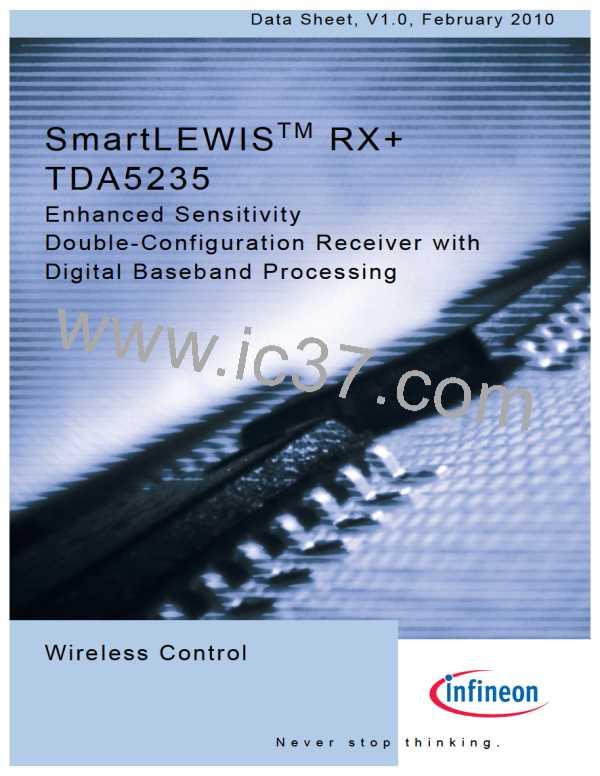TDA5235
Functional Description
Signal and Noise Detector
The Signal Detector decides between acceptable and unacceptable data (e.g. noise).
This decision is taken by comparing the signal power of the actually received data
(register SPWR) with a configurable threshold level (registers x_SIGDET0/1), which
must be evaluated. In case the actual signal power is above the threshold, acceptable
data has been detected.
To decide in case of FSK whether there is a data signal or simply noise at the output of
the rate adapter, there is a Noise Detector implemented. The principle is based on a
power measurement of the demodulated signal. The current noise power is stored in the
NPWR register and is updated at every SPI controller access. The Noise Detector is
useful if data signal is transmitted with small FSK deviations. In case the current noise
power (register NPWR) is below the configurable threshold (register x_NDTHRES), a
data signal has been detected.
The Signal Recognition mode must be configured based on whether ASK or FSK
modulation is used. Signal Recognition can be a combination of Signal Detector and
Noise Detector:
• Signal Detector (=Squelch) only (related registers: x_SIGDET0, x_SIGDET1 and
SPWR). This mode is generally used for ASK and recommended for FSK.
• Noise Detector only (related registers: x_NDTHRES and NPWR).
• Signal and Noise Detector simultaneously.
• Signal and Noise Detector simultaneously, but the FSK noise detect signal is valid
only if the x_SIGDETLO threshold is exceeded. This is the recommended FSK mode,
if minimum FSK deviation is not sufficient to use Signal Detector only.
Signal Recognition can also be used as Wake-up on Level criterion (see
Chapter 2.4.8.5).
Figure 16 shows the system characteristics to consider in choosing the best Signal
Detector level. On the one hand, a higher SIGDET threshold level must be set for
achieving good FAR (False Alarm Rate) performance, but then the MER/BER (Message
Error Rate/Bit Error Rate) performance will decrease. On the other hand, the MER/BER
performance can be increased by setting smaller SIGDET threshold levels but then the
FAR performance will worsen.
Data Sheet
39
V1.0, 2010-02-19

 INFINEON [ Infineon ]
INFINEON [ Infineon ]